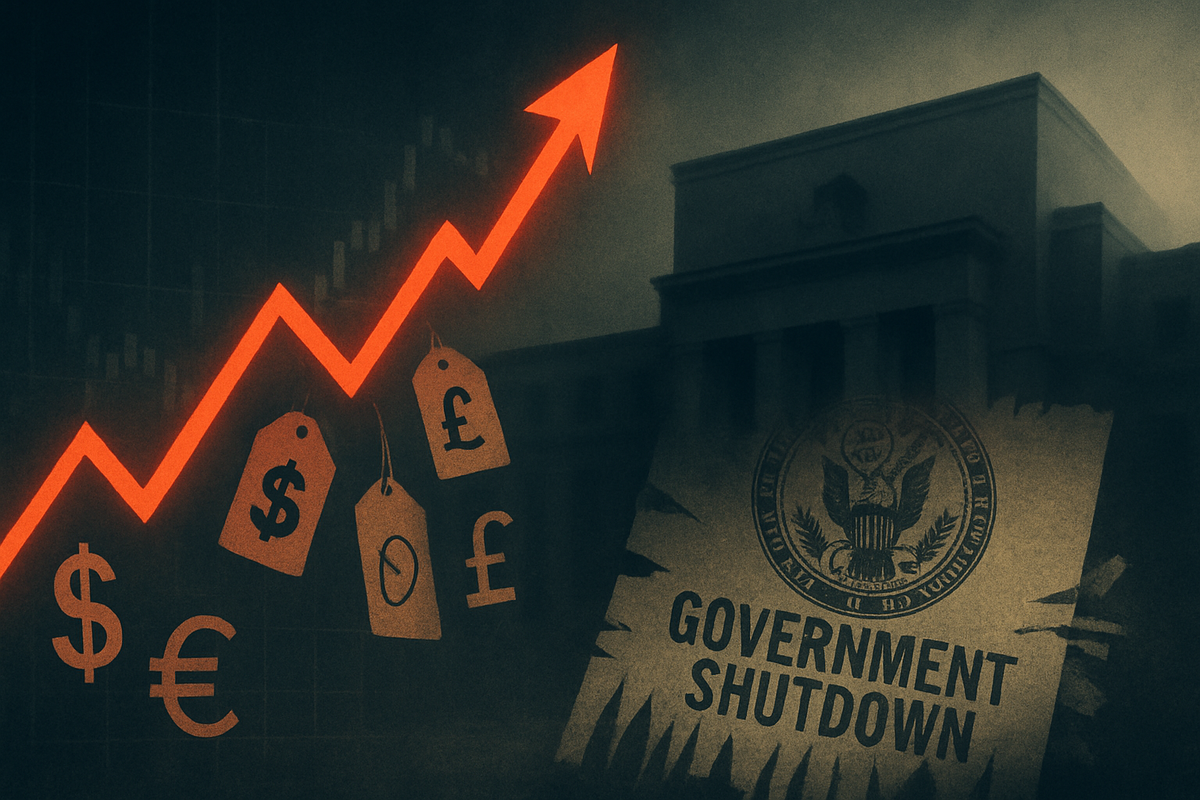Inflation's Shadow Lengthens: September CPI Ignites Fed Caution Amidst Government Shutdown

Washington D.C., October 10, 2025 – The financial markets are bracing for impact as the September 2025 Consumer Price Index (CPI) report looms, a critical piece of economic data that promises to shine a harsh light on persistent inflation. This report, due for release amidst an ongoing government shutdown, is igniting profound caution at the Federal Reserve, which finds itself in an unenviable position: attempting to steer the economy toward price stability with one hand tied behind its back due to a data blackout. The confluence of stubbornly high prices, a politically paralyzed government, and a central bank operating with limited visibility presents a perilous path forward for the U.S. economy.
The anticipated September CPI figures are expected to confirm that inflationary pressures are far from abating. This continued upward trajectory in consumer prices threatens to erode purchasing power, heighten economic uncertainty, and complicate the Federal Reserve's delicate dance between taming inflation and supporting a potentially softening labor market. As the government shutdown extends, delaying crucial economic indicators, the Fed's ability to make informed decisions is severely hampered, leaving investors and businesses to navigate a fog of incomplete information.
The Data Blackout: Unpacking September's CPI and a Paralyzed Government
The September 2025 CPI report, typically a cornerstone of economic analysis, takes on heightened significance due to the current environment. Building on August's concerning figures, where the CPI rose 0.4% month-over-month, pushing the year-over-year rate to 2.9% (up from 2.7% in July), the upcoming report is expected to reinforce the narrative of entrenched inflation. Core CPI, which excludes volatile food and energy prices and is a key metric for policymakers, also remained a concern, increasing 3.1% annually in August. These figures suggest that price pressures are broadening across the economy, driven by factors such as lingering tariff impacts on goods like household furnishings and cars, and elevated services prices including airfares and shelter.
The timeline leading up to this moment has been fraught with tension. Despite a cooling labor market, which saw the Federal Reserve implement its first quarter-point interest rate cut of the year in September, lowering the federal funds rate by 25 basis points, the move was far from unanimous. Minutes from the Federal Open Market Committee (FOMC) meeting revealed deep internal divisions, with some policymakers prioritizing a slowing job market while others voiced significant concern over persistent inflation. Minneapolis Fed President Neel Kashkari notably flagged "stagflationary signals" due to tariffs, where prices rise alongside stagnant growth. This internal debate highlights the challenging position the Fed finds itself in, with "no risk-free path forward" to balance its dual mandate of maximum employment and price stability.
Adding to this complexity, the U.S. government officially shut down on October 1, 2025, after Congress failed to pass a new spending bill. This impasse has created an immediate "data blackout," delaying the release of vital economic statistics, including the September CPI report and jobs reports. While the Bureau of Labor Statistics (BLS) may prioritize the CPI release due to its implications for Social Security cost-of-living adjustments, other critical data will remain elusive. This leaves key players like the Federal Reserve, investors, and businesses "operating a little bit blind," forced to make decisions based on incomplete and potentially outdated information. The initial market reactions have seen some volatility, but the true economic ramifications of this data vacuum are yet to be fully realized.
Navigating the Economic Currents: Winners and Losers in a High-Inflation, High-Uncertainty Market
The current economic climate, characterized by persistent inflation, elevated interest rates, and the uncertainty of a government shutdown, creates a distinct bifurcation in the market, favoring some sectors while challenging others.
Winning Sectors and Companies:
- Financial Services: Large commercial banks like Citigroup (NYSE: C) and U.S. Bancorp (NYSE: USB) often benefit from higher interest rates, which can boost their net interest income (NII). Insurance companies such as The Travelers Companies (NYSE: TRV) and Chubb (NYSE: CB) also see increased investment income from their portfolios in a higher rate environment.
- Consumer Staples: Companies providing essential goods, such as PepsiCo (NASDAQ: PEP), Coca-Cola (NYSE: KO), and Procter & Gamble (NYSE: PG), tend to be resilient. Their strong brands and pricing power allow them to pass on increased costs to consumers, making them defensive investments during economic uncertainty. Discount retailers like Walmart (NYSE: WMT) also thrive as consumers seek value.
- Utilities: Providers of essential services like electricity, water, and gas, including NextEra Energy (NYSE: NEE), offer stable demand and are often favored for their consistent dividends.
- Energy and Materials: Commodity producers such as Exxon Mobil (NYSE: XOM) and Chevron (NYSE: CVX) often benefit from inflation as the value of their assets and product prices increase.
- Healthcare: Companies like Merck (NYSE: MRK) and Pfizer (NYSE: PFE), along with managed healthcare providers like UnitedHealth Group (NYSE: UNH), typically see stable demand for their non-discretionary services.
Losing Sectors and Companies:
- Technology (Growth Stocks): High interest rates disproportionately impact growth-oriented technology companies. Their future projected earnings are discounted more heavily, affecting valuations. Companies like Salesforce (NYSE: CRM), Adobe (NASDAQ: ADBE), and Amazon (NASDAQ: AMZN) may face headwinds from higher borrowing costs and reduced consumer discretionary spending.
- Consumer Discretionary: Goods and services that consumers can easily cut back on, such as automobiles from Tesla (NASDAQ: TSLA) or General Motors (NYSE: GM), apparel from Nike (NYSE: NKE), and luxury items, will suffer. Restaurants like McDonald's (NYSE: MCD) and travel companies like Carnival Corp. (NYSE: CCL) are also vulnerable.
- Real Estate: This sector is highly sensitive to interest rates, with rising mortgage costs dampening demand for new homes and impacting developers like Lennar (NYSE: LEN) and D.R. Horton (NYSE: DHI).
- Industrials: Companies heavily reliant on government contracts, such as smaller defense contractors or IT service providers to federal agencies, will face disruptions from the shutdown. Manufacturing firms with limited pricing power also struggle with increased input costs.
- Companies Planning IPOs or Capital Raises: The government shutdown significantly curtails the operations of the Securities and Exchange Commission (SEC), making it difficult for Initial Public Offerings (IPOs) and other registration statements to become effective. This effectively freezes access to capital markets for many private and public companies.
Wider Significance: A Global Ripple Effect and Historical Echoes
The current economic quagmire extends far beyond domestic borders, fitting into broader global trends and carrying significant international ripple effects. Persistent U.S. inflation, potentially fueled by tariffs, can contribute to global inflationary pressures, compelling other central banks to maintain tighter monetary policies. Global supply chain costs are projected to rise significantly by late 2025 due to tariff deadlines, labor pressures, and fractured trade flows. A U.S. government shutdown exacerbates these issues by causing regulatory delays, slowing import documentation, and impacting export licensing, leading to further disruptions and increased costs for both domestic and international partners.
The U.S. labor market, while showing signs of softening, remains tight in some metrics, with wage growth still higher than pre-pandemic levels. Coupled with persistent inflation, this can contribute to a wage-price spiral, especially if workers seek to regain lost purchasing power. The Fed's caution reflects the "challenging position" of balancing inflation risks with potential vulnerabilities in the labor market.
Internationally, U.S. economic instability and uncertainty, compounded by the shutdown, would affect global trade and investment. Delays in export licenses and regulatory reviews would disrupt global supply chains. A strong U.S. dollar, potentially fueled by the perception of relative U.S. resilience or unpredictable U.S. monetary policy, would tighten financial conditions for emerging markets, amplifying their debt burdens and potentially leading to portfolio outflows.
Beyond monetary policy, the government shutdown itself represents a failure of fiscal policy, demonstrating an inability to pass funding legislation. A prolonged shutdown could lead to deeper spending cuts or permanent workforce reductions, impacting government services and long-term economic planning. Trade policy, particularly the role of tariffs in contributing to inflation, highlights its significant impact on global markets. Regulatory backlogs due to agency shutdowns could compromise oversight in areas like public safety, environmental protection, and consumer product safety, with both domestic and international repercussions.
Historically, the U.S. has experienced numerous government shutdowns, varying in duration. While these events typically trim GDP growth by about 0.2-0.6% per week, the stock market's reaction has generally been muted, with quick recoveries. However, the current confluence of high inflation and Fed caution could make markets more sensitive. Data blackouts during previous shutdowns have left the Federal Reserve "operating a little bit blind," forcing it to rely on alternative data or postpone decisions. The Fed's current cautious stance reflects lessons learned from the 1970s, where inflation became entrenched, requiring aggressive and prolonged tightening to bring it under control. The focus on well-anchored inflation expectations is a key takeaway from these historical periods.
What Comes Next: Navigating the Fog of Uncertainty
The immediate future is shrouded in uncertainty, with the duration of the government shutdown being a primary determinant of short-term economic health. Each week of the shutdown directly drags on GDP, impacting consumer spending and business activity. For the Federal Reserve, the data blackout creates an immense challenge, forcing it to rely on incomplete information. Given persistent inflation, the Fed faces a dilemma: cut rates to support an economy weakened by the shutdown, risking further inflation, or hold steady to fight inflation, risking a deeper slowdown. Fiscal policy, meanwhile, remains paralyzed until the shutdown is resolved.
In the long term, a prolonged or recurring shutdown could inflict permanent damage on the economy, eroding confidence in U.S. fiscal management, potentially leading to credit rating downgrades, and weakening the U.S. dollar's global reserve status. Persistent high inflation, if unchecked, could distort investment patterns and reduce productivity. If a stagflationary scenario (high inflation, slow growth) takes hold, the Fed might be forced to keep monetary policy restrictive for longer, even with a sluggish economy, to prevent inflation expectations from becoming unanchored.
Strategic Pivots and Adaptations:
- For Businesses: Robust cash flow management, strategic pricing, aggressive cost control, and diversification of supply chains are paramount. Scenario planning and building financial reserves will be crucial.
- For Investors: Increasing exposure to inflation hedges like Treasury Inflation-Protected Securities (TIPS), commodities, and real estate (e.g., Real Estate Investment Trusts, or REITs) is advisable. Diversification, reducing exposure to long-duration bonds and low-yield cash, and focusing on companies with strong pricing power are key strategies. Safe-haven assets like gold and U.S. Treasuries may also see increased demand.
Market Opportunities and Challenges:
Opportunities may arise from a post-shutdown market rebound, and resilient sectors like healthcare and utilities could offer stability. Value stocks and real assets are generally favored in inflationary environments. However, challenges include heightened market volatility, the ongoing data blackout making informed decisions difficult, and vulnerable sectors (consumer discretionary, high-debt businesses) facing significant headwinds.
Potential Scenarios:
- Prolonged Shutdown & Stagflationary Trap: A protracted shutdown combined with persistent inflation leads to a severe economic slowdown or recession with high inflation and rising unemployment. This would result in substantial market declines and a weaker dollar.
- Short Shutdown & "Reluctant Dove" Fed: A quick resolution to the shutdown, coupled with signs of labor market weakening, convinces the Fed to proceed with measured interest rate cuts. This could lead to a "soft landing" or managed slowdown, but inflation remains a concern.
- Deepening Political Dysfunction & Systemic Erosion: The shutdown becomes part of a broader pattern of political instability, leading to frequent disruptions and entrenched inflation. This would result in a long-term erosion of U.S. economic competitiveness, permanent damage to investor confidence, and a sustained depreciation of the dollar.
Wrap-Up: A Test of Resilience
The September 2025 CPI report, released under the cloud of a government shutdown and scrutinized by a cautious Federal Reserve, marks a critical juncture for the U.S. economy. The key takeaway is the persistent nature of inflation, which continues to hover above the Fed's target, forcing a delicate balancing act with monetary policy. The government shutdown, meanwhile, creates an unprecedented data vacuum, significantly handicapping the Fed's ability to make informed decisions and amplifying market uncertainty.
Moving forward, the market will likely remain volatile, with a constant re-evaluation of economic indicators and central bank policy expectations. The resilience of equity markets, particularly in the tech sector, despite grim consumer sentiment, highlights the market's focus on potential future Fed rate cuts. However, this optimism could be fragile, especially if delayed data reveals a more challenging economic picture.
The lasting impact of this period could be a recalibration of how financial markets weigh different economic indicators, with central bank policy expectations taking on an even more dominant role. Beyond immediate fluctuations, prolonged government dysfunction risks eroding public confidence and could have long-term consequences, potentially extending government downsizing and acting as a drag on payrolls into the next year.
What Investors Should Watch For:
- Resolution of the Government Shutdown: A swift end could alleviate some uncertainty, but the eventual release of delayed economic data may reveal a more challenging picture.
- Federal Reserve Communications: Scrutinize any statements or minutes from the Federal Reserve regarding monetary policy. Any indication that the Fed might be less aggressive with rate cuts than anticipated could trigger market corrections.
- Inflation Trends: Beyond just the headline CPI figures, pay close attention to core inflation, the impact of tariffs, and services inflation. Higher-than-expected inflation remains a key factor that could deter further rate reductions.
- Labor Market Dynamics: Monitor signs of significant weakening in the labor market, as this could put pressure on the Fed to prioritize employment over inflation.
- Corporate Earnings and Guidance: Observe how companies are managing rising costs and adapting to reduced consumer spending.
This content is intended for informational purposes only and is not financial advice
More News
View More




Recent Quotes
View More
Quotes delayed at least 20 minutes.
By accessing this page, you agree to the Privacy Policy and Terms Of Service.